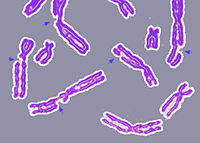
Inhibition of the catalytic subunit of DNA‐dependent protein kinase (DNA‐PKcs) stimulates osteoblastogenesis by potentiating bone morphogenetic protein 2 (BMP2) responses
Sign Up to like & getrecommendations! Published in 2020 at "Journal of Cellular Physiology"
DOI: 10.1002/jcp.29927
Abstract: The catalytic subunit of DNA‐dependent protein kinase (DNA‐PKcs) is a pleiotropic enzyme involved in DNA repair, cell cycle control, and transcription regulation. A potential role for DNA‐PKcs in the regulation of osteoblastogenesis remains to be… read more here.
Keywords: protein; dna pkcs; dna; kinase ... See more keywords

Targeted and systemic insights into the crosstalk between DNA-dependent protein kinase catalytic subunit and receptors of estrogen, progesterone and epidermal growth factor in the context of cancer.
Sign Up to like & getrecommendations! Published in 2021 at "Molecular biology reports"
DOI: 10.1007/s11033-021-06797-w
Abstract: DNA-dependent protein kinase catalytic subunit (DNA-PKcs) has emerged as a regulator of carcinogenesis. Increased expression of DNA-PKcs correlates with metastatic cancers. Here we review recently reported crosstalk of DNA-PKcs with estrogen (ER), progesterone (PR) and… read more here.
Keywords: dna dependent; dna; dna pkcs; dependent protein ... See more keywords

micorRNA-101 silences DNA-PKcs and sensitizes pancreatic cancer cells to gemcitabine.
Sign Up to like & getrecommendations! Published in 2017 at "Biochemical and biophysical research communications"
DOI: 10.1016/j.bbrc.2016.12.074
Abstract: Gemcitabine sensitization is important for the treatment of pancreatic cancer. We have previously shown that DNA-dependent protein kinase catalytic subunit (DNA-PKcs) over-expression causes Akt activation and gemcitabine resistance in pancreatic cancer cells. Here, we aim… read more here.
Keywords: pancreatic cancer; pkcs; mir 101; dna pkcs ... See more keywords

Severe hypoxia increases expression of ATM and DNA-PKcs and it increases their activities through Src and AMPK signaling pathways.
Sign Up to like & getrecommendations! Published in 2018 at "Biochemical and biophysical research communications"
DOI: 10.1016/j.bbrc.2018.09.068
Abstract: BACKGROUND Solid tumors often contain hypoxic regions because an abnormal and inefficient tumor vasculature is unable to supply sufficient oxygen. Tissue hypoxia is generally defined as a low oxygen concentration of less than 2%. It… read more here.
Keywords: dna pkcs; severe hypoxia; atm dna;

Inhibition of DNA-PKcs activity re-sensitizes uveal melanoma cells to radio- and chemotherapy.
Sign Up to like & getrecommendations! Published in 2019 at "Biochemical and biophysical research communications"
DOI: 10.1016/j.bbrc.2019.11.133
Abstract: Uveal melanoma (UM) is the most common primary intraocular tumor in adults. Despite of important progress in the local therapy, high radioresistance in primary tumor and chemoresistance in metastatic disease are the major obstacles for… read more here.
Keywords: chemotherapy; dna pkcs; dna; uveal melanoma ... See more keywords

Deciphering phenotypic variance in different models of DNA-PKcs deficiency.
Sign Up to like & getrecommendations! Published in 2019 at "DNA repair"
DOI: 10.1016/j.dnarep.2018.10.004
Abstract: DNA-PKcs deficiency has been studied in numerous animal models and cell culture systems. In previous studies of kinase inactivating mutations in cell culture systems, ablation of DNA-PK's catalytic activity results in a cell phenotype that… read more here.
Keywords: pkcs deficiency; dna; pkcs deficient; dna pkcs ... See more keywords

Positive Feedback Regulation of Poly(ADP-ribose) Polymerase 1 and the DNA-PK Catalytic Subunit Affects the Sensitivity of Nasopharyngeal Carcinoma to Etoposide
Sign Up to like & getrecommendations! Published in 2022 at "ACS Omega"
DOI: 10.1021/acsomega.1c04379
Abstract: Etoposide (VP-16) is used for the treatment of various cancers, including nasopharyngeal carcinoma (NPC); however, cancers develop resistance to this agent by promoting DNA repair. The DNA-PK (DNA-PKcs) catalytic subunit and poly(ADP-ribose) polymerase 1 (PARP1)… read more here.
Keywords: nasopharyngeal carcinoma; polymerase; dna; dna pkcs ... See more keywords

Physical ARTEMIS:DNA-PKcs interaction is necessary for V(D)J recombination
Sign Up to like & getrecommendations! Published in 2022 at "Nucleic Acids Research"
DOI: 10.1093/nar/gkac071
Abstract: Abstract The nuclease ARTEMIS and the DNA-dependent protein kinase catalytic subunit (DNA-PKcs) are involved in the repair of physiological and pathogenic DNA double strand breaks. Both proteins are indispensable for the hairpin-opening activity in V(D)J… read more here.
Keywords: dna pkcs; interaction; dna; artemis dna ... See more keywords

Structural analysis of the basal state of the Artemis:DNA-PKcs complex
Sign Up to like & getrecommendations! Published in 2022 at "Nucleic Acids Research"
DOI: 10.1093/nar/gkac564
Abstract: Abstract Artemis nuclease and DNA-dependent protein kinase catalytic subunit (DNA-PKcs) are key components in nonhomologous DNA end joining (NHEJ), the major repair mechanism for double-strand DNA breaks. Artemis activation by DNA-PKcs resolves hairpin DNA ends… read more here.
Keywords: dna; artemis dna; dna pkcs; pkcs complex ... See more keywords

PIDD mediates the association of DNA-PKcs and ATR at stalled replication forks to facilitate the ATR signaling pathway
Sign Up to like & getrecommendations! Published in 2018 at "Nucleic Acids Research"
DOI: 10.1093/nar/gkx1298
Abstract: Abstract The DNA-dependent protein kinase (DNA-PK), consisting of the DNA binding Ku70/80 heterodimer and the catalytic subunit DNA-PKcs, has been well characterized in the non-homologous end-joining mechanism for DNA double strand break (DSB) repair and… read more here.
Keywords: stalled replication; signaling pathway; dna pkcs; dna ... See more keywords

Effects of melatonin on fatty liver disease: The role of NR4A1/DNA‐PKcs/p53 pathway, mitochondrial fission, and mitophagy
Sign Up to like & getrecommendations! Published in 2018 at "Journal of Pineal Research"
DOI: 10.1111/jpi.12450
Abstract: Mitochondrial dysfunction has been implicated in the pathogenesis of nonalcoholic fatty liver disease (NAFLD) through poorly defined mechanisms. Melatonin supplementation has been found to protect liver function in diabetes and obesity. Here, we intensively explored… read more here.
Keywords: nr4a1 dna; p53; pkcs p53; dna pkcs ... See more keywords